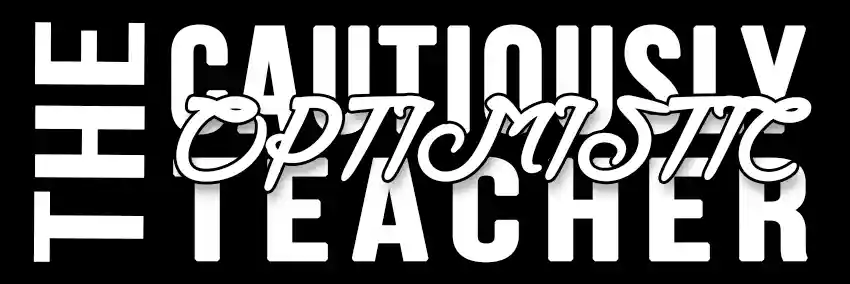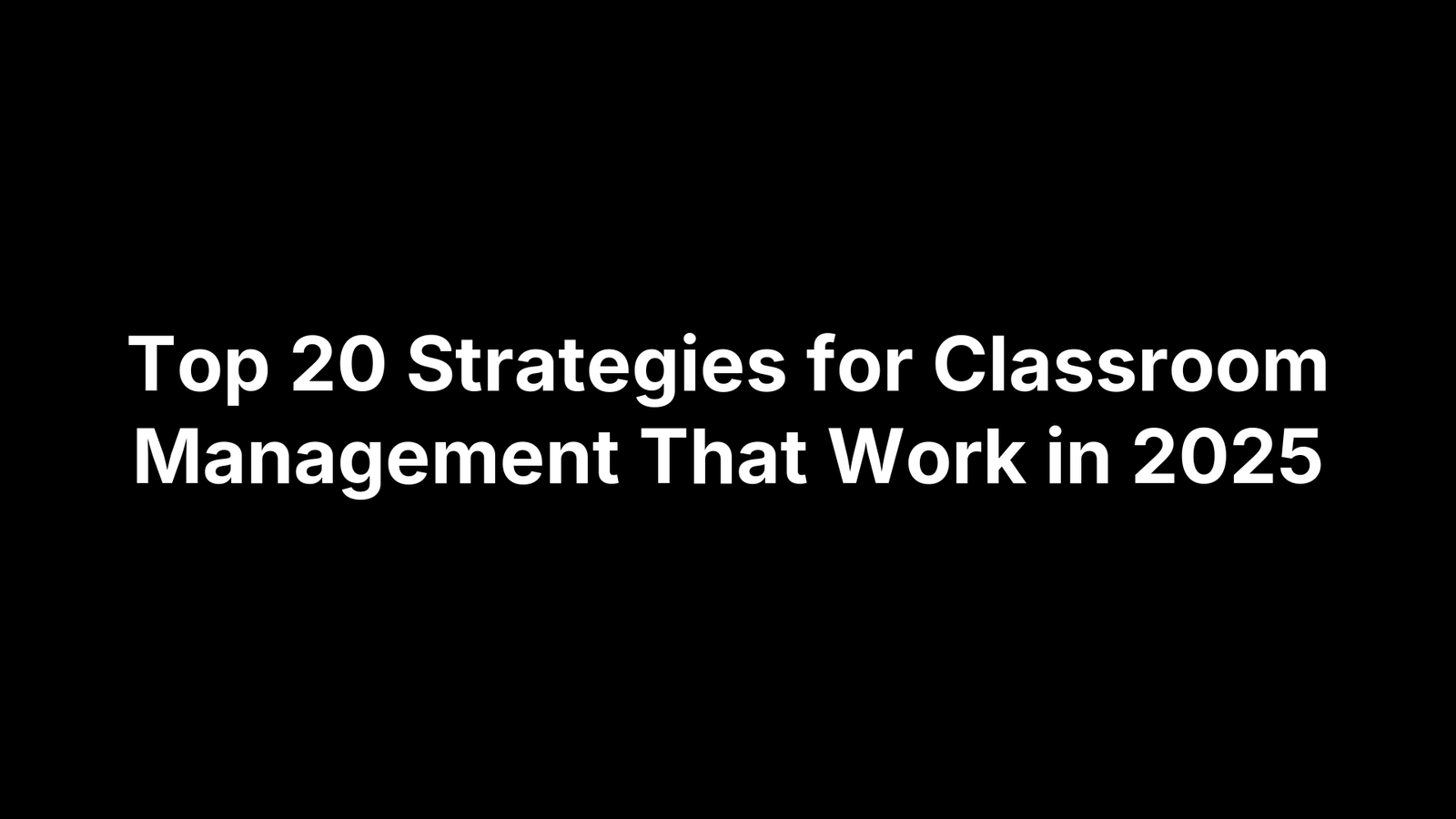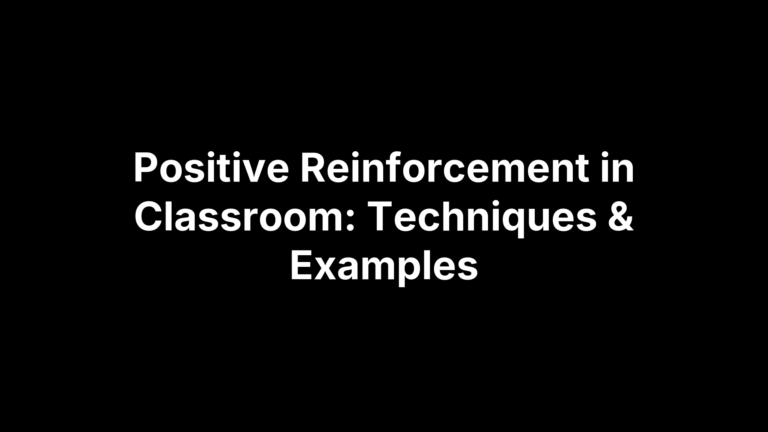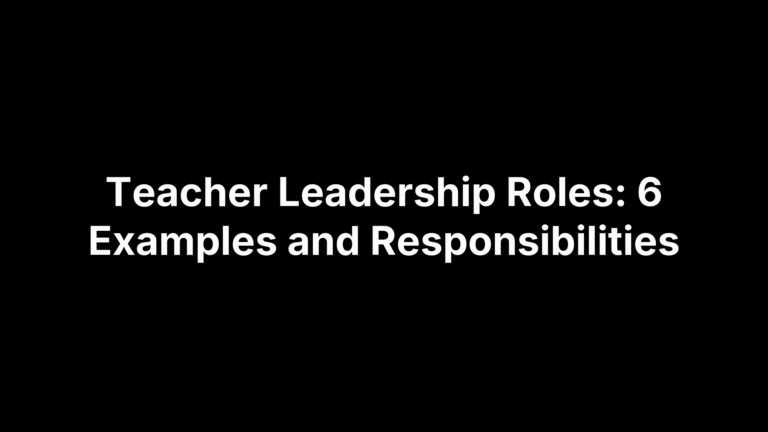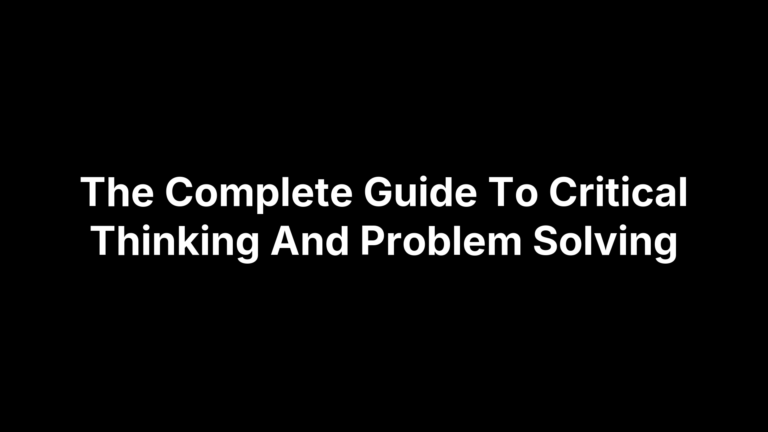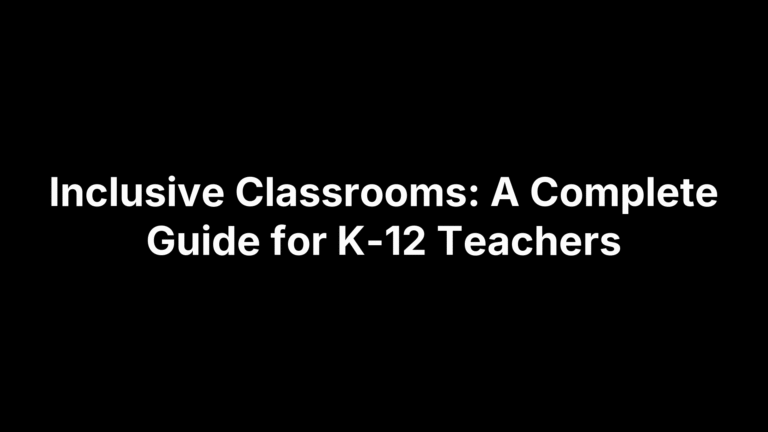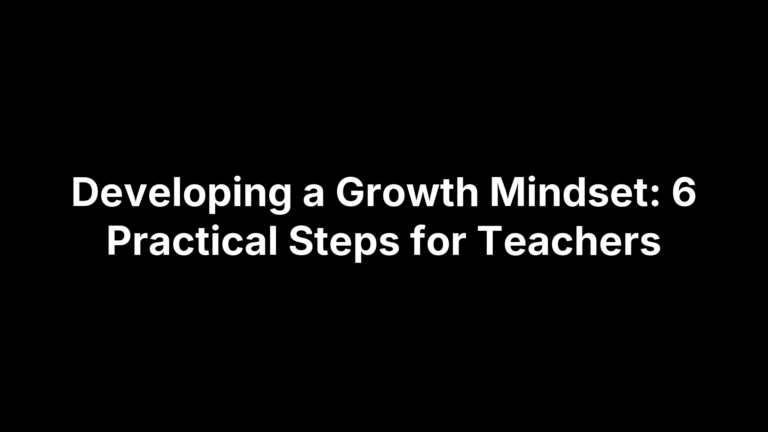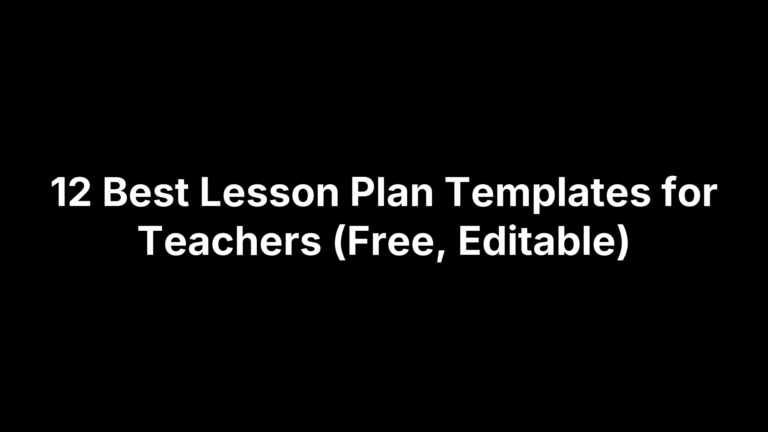Incredible Strategies for Classroom Management That Improve Student Engagement
You’re juggling TikTok pings, AI chatbots, and thirteen kinds of student stress before the bell even rings. No wonder managing behavior can feel like spinning plates on a hoverboard. Enter the need for effective strategies for classroom management.
The good news: there are practical moves that work right now. This guide delivers 20 strategies you can test tomorrow morning—each sharpened for 2025’s tech-heavy classrooms, SEL priorities, and wildly diverse learning profiles. You’ll see a balance of classic teacher wisdom—think modeling, routines, and proximity—with fresh tools like AI dashboards and restorative chat apps. Ready to trade chaos for calm? Let’s dive straight into the methods teachers say are saving their sanity in 2025. Pick two to pilot this week, measure the difference, then come back for more. Your future self—and your students—will thank you. Let’s get started.
1. Leverage AI-Powered Tools (e.g., The Cautiously Optimistic Teacher Suite)
Smart use of artificial intelligence is quickly climbing the list of go-to strategies for classroom management. When algorithms handle the repetitive grunt work, teachers reclaim bandwidth for relationship-building—and fewer bored, ignored, or confused students means fewer behavior flare-ups.
Why AI Is a Classroom Management Game-Changer in 2025
AI now predicts skill gaps, auto-groups learners, and drafts parent updates in seconds. The payoff is tighter differentiation, faster feedback, and lower teacher stress. Stick to district privacy policies, disable data sharing beyond the classroom, and keep a human eye on every suggestion.
Practical Ways to Integrate Our AI Tools
- Differentiated Instruction Helper creates leveled reading passages so every student hits flow state, not frustration.
- Worksheet Maker spits out five-minute bell ringers—instantly establishing a calm, purposeful startup routine.
- Report Card Commentor frees up hours that you can invest in hallway check-ins or restorative chats.
Dos, Don’ts, and Real-Life Example
- Do start with one class period and model how the tool works.
- Do narrate your commitment to data privacy.
- Don’t hand student data to outside apps or let the bot pick grades.
An 8th-grade ELA teacher used the Suite to build three leveled stations. Chatter dropped 50 %, transitions ran smoother, and she ended the day with energy to spare—a small but powerful proof that AI belongs on the front line of classroom management.
2. Co-Create Clear, Positive Classroom Norms with Students
Nothing kills buy-in faster than a list of “thou-shalt-nots” taped above the whiteboard. Collaborating on classroom norms reframes behavior expectations as shared community values—boosting ownership and reducing power struggles.
From Rules to Agreements: Shifting the Language
Swap “rules” for “agreements.” Research on autonomy shows that when students help define expectations, on-task behavior rises and referrals drop.
Step-by-Step Protocol for a Norm-Setting Session
- Ice-breaker “ideal class” brainstorm
- Sort behaviors into themes (respect, readiness, risk-taking)
- Vote to condense into 4–6 succinct norms
- Create visual posters and digital slides
- Schedule a mid-year 15-minute reset to revisit and revise
Maintaining Consistency Without Becoming Authoritarian
Use a calm “gentle reminder” script: “Remember our ‘listen first’ agreement.” Follow up privately if needed, then circle back to positive reinforcement when students realign—firm yet relational.
3. Model the Behaviors You Expect Every Single Day
Students study us like TikTok clips—frame by frame—so our own habits either reinforce or undercut every other strategy on this list. Consistent, visible modeling is one of the simplest yet most overlooked strategies for classroom management.
The Science Behind Mirror Neurons
Brain-imaging studies show that “mirror” neurons fire when learners observe someone else acting. Tone, posture, even the way you silence your phone primes students to do the same. In short, they can’t mirror what they never see.
Micro-Behaviors to Model
- Say “please” and “thank you” to students
- Close your laptop when a learner speaks
- Use eye contact and nods for active listening
- Tuck your phone away during work time
Self-Audit Sheet for Teachers
Ask yourself daily:
- Did I greet every class warmly?
- Was my device use aligned with expectations?
- Did I interrupt or listen fully?
- Did I model calm cue words during transitions?
Keep notes and adjust tomorrow.
4. Establish Predictable Routines and Micro-Transitions
A rock-solid routine is the unsung hero of modern classroom management. When students can predict what happens next, they spend less energy decoding expectations and more on learning. Think of routines as the autopilot layer beneath all other strategies for classroom management.
Why Routines Reduce Cognitive Load
Predictability trims extraneous cognitive load, freeing working memory for content. Neurological studies show the brain releases less cortisol when sequences feel familiar—meaning calmer students and smoother lessons.
Designing Entry, Exit, and Material-Getting Procedures
- Entry: Silent bell ringer on desks, backpacks against the wall, devices face-down.
- Exit: Two-minute recap slide, quick desk sweep, line up when the timer dings.
- Materials: Color-coded bins per table; one “Runner” retrieves supplies to cut traffic.
Lock these three first; everything else layers on easily.
Troubleshooting When a Routine Breaks Down
- Reteach the exact steps—model, then student volunteers demo.
- Practice with a stopwatch until the class meets the time goal.
- Reinforce with specific praise or a class point.
- Reflect: Ask students what derailed the routine and co-create a fix.
A 10-minute reset today saves hours of redirection tomorrow.
5. Use Proximity and Strategic Movement
Standing still at the front is an invitation for off-task whispers. Strategic roaming turns your body into a quiet reminder that learning matters and puts you close enough to answer questions before they snowball into disruptions.
Evidence for Proximity Control
Meta-analyses show a 70 % drop in minor disruptions when teachers circulate every two minutes. Closer presence narrows attention, turns corrections into a simple eyebrow raise, and boosts engagement scores on walk-through rubrics.
Mapping a Movement Plan
Sketch your room, then mark five “hot spots” where issues spark—doorway, supply shelf, back row. Design a looping path that reaches each spot every 90 seconds without tripping over cords or backpacks.
Non-Verbal Cues to Pair with Proximity
Combine movement with silent signals: tap the desk edge, slide a sticky note reminder, or rest a hand on a table. Students get redirected without the stigma of public call-outs.
6. Build Relationships Through Daily Check-Ins
Students behave better for teachers who know them beyond the gradebook. A brisk, intentional check-in at the start of class says “I see you,” collects quick SEL data, and lets you spot brewing storms before they hit instruction.
Greeting at the Door 2.0
Stand at the threshold, make eye contact, offer a fist bump, then flash a digital “emoji meter” on your tablet for students to tap. You’ve welcomed them and captured mood data in under ten seconds.
Quick SEL Surveys and Mood Meters
Project a QR code linking to a one-question Google Form (green = ready, yellow = tired, red = need support) or use laminated mood meters with dry-erase markers for phone-free classes.
Differentiating Check-Ins for Introverts vs. Extroverts
Provide silent journals or a “thought box” for students who prefer writing, while chatty learners can request a hallway walk-and-talk pass. Both options honor comfort zones and maintain connection.
7. Integrate Positive Behavior-Specific Feedback (PBSF)
Research keeps showing that the fastest way to steer conduct is to spotlight what’s already working. Deliberate, behavior-specific praise turns good moments into models for the whole room and anchors your broader strategies for classroom management.
Anatomy of an Effective Praise Statement
Use the formula Name + Behavior + Impact:
- “Jordan, you moved to the collaboration zone quietly, which kept everyone focused.”
Keep it audible, authentic, and immediate—within 30 seconds of the action.
4:1 Positive-to-Corrective Ratio
Aim for four acknowledgments of desired behavior for every redirect. Track on a sticky note or clicker; most teachers notice smoother transitions once they hit that ratio consistently.
Avoiding Praise Inflation
Skip generic “good jobs.” Rotate vocabulary (appreciate, noticed, impressed), praise effort over talent, and occasionally deliver kudos privately to maintain sincerity and student dignity.
8. Implement Restorative Practices Instead of Punishment
Detentions and zero-tolerance slips rarely teach skills; they just push problems to tomorrow. Restorative approaches trade punishment for dialogue that repairs harm, rebuilds trust, and coaches self-regulation—research shows referrals drop 40 %.
Circles, Conferences, and Reflection Sheets
- Circle: class dialogue after a shared disruption; aim—collective solutions.
- Conference: 10-min meeting with involved parties to address specific harm.
- Reflection sheet: quick form for minor missteps; student notes impact + next step.
Sample Dialogue Scripts
Ask: “What happened?” → “Who was affected?” → “How can we make it right?” Let students propose fixes first.
Aligning Restorative Practices with School Policies
- Record each circle/conference in the school tracker.
- Send guardians the plan within 24 hours.
- Alert admin when safety is at stake.
9. Gamify Participation and Behavior
Nothing rallies a class faster than a leaderboard. Gamification layers fun onto the strategies for classroom management you already use, turning compliance into voluntary quests.
Elements of Game Design That Motivate Learners
- Clear goals
- Immediate feedback loop
- Visible progress bars
- Level-up milestones
- Redeemable rewards
Low-Prep Gamification Ideas
- Sticker quests for quiet transitions
- Random raffle tickets for on-task groups
- “Boss battle” review games versus teacher
- Digital badges for punctual assignment uploads
Digital vs. Analog Platforms
Apps like ClassDojo or a shared Google Sheet crunch points automatically, while poster boards and jar marbles keep screens off. Pick the format that best matches your tech norms and student preferences.
10. Optimize Flexible Seating and Physical Layout
Furniture isn’t neutral; the way you arrange it nudges behavior, focus, and collaboration more than any speech ever will.
Linking Environment to Self-Regulation
Ergonomic chairs, soft lighting, and minimal visual clutter reduce sensory overload, letting students’ prefrontal cortex stay in charge instead of fight-or-flight instincts.
Creating Zones
Label three clear areas: Focus Zone (single desks, noise-canceling headphones), Collaboration Zone (tables, whiteboards), Calm-Down Corner (beanbag, sand timer). Explicitly teach when to use each.
Managing Seat Choice Privileges
Offer free seating after routines stick; track responsible use with a simple green-yellow-red chart. If misuse spikes, reset expectations, assign seats for a week, then re-release.
11. Teach and Rehearse Digital Citizenship
Phones and Chromebooks aren’t going away, so teaching students to use them responsibly must sit alongside your other strategies for classroom management. A short, recurring focus on digital norms keeps learning on track and limits late-night “missing assignment” emails.
Why Device Misuse Is Today’s #1 Distraction
Recent surveys show secondary students average 65 notification pings per class period. Each alert fractures attention and invites plagiarism shortcuts. Clear norms plus rehearsal cut off-task clicks by nearly a third, according to 2024 NCTQ walkthrough data.
5 Mini-Lessons on Net Etiquette & Screen Boundaries
- Respectful chat threads (no ALL-CAPS shouting)
- Credible sourcing vs. copy-paste temptation
- Headphone volume etiquette in shared spaces
- “Camera on” expectations during hybrid sessions
- Two-minute tech pause when peers present
Monitoring Tools and Student Self-Monitoring Logs
Use free apps like Google’s “Focus Timer” or a simple analog tally sheet to track on-task minutes. Students graph their data weekly, set a micro-goal, and celebrate growth.
12. Use Data-Driven Behavior Tracking
Gut feelings help, but numbers end arguments. Behavior tracking reveals patterns hidden in the daily whirlwind and arms you with evidence for parents, admins, and IEP teams.
Key Metrics to Record
Log frequency, duration, and intensity of behaviors plus simple ABC notes—Antecedent, Behavior, Consequence. Tag context (group work, lecture, transition) so you can isolate triggers instead of guessing.
Free & Paid Apps for Quick Data Logging
Google Forms with dropdowns works for zero dollars; ClassCharts auto-graphs patterns; EduClimber syncs with SIS for multi-teacher views. All three let you timestamp entries on a phone as you circulate.
Translating Data into Action Plans
After a week, color-code the spreadsheet, look for spikes, and draft a goal: “reduce call-outs from six to two per period.” Share the graph with the student and brainstorm strategies together.
13. Incorporate Brain Breaks and Mindfulness Moments
Short, structured pauses keep students’ brains from slipping into distraction overload. A well-timed stretch or breath can reset focus faster than any reprimand.
Neuroscience of Attention Spans in 2025
Updated fMRI studies pin adolescent sustained attention at roughly 12 minutes before dopamine and oxygen levels dip. A one-minute movement or mindfulness reset re-activates the prefrontal cortex, boosting working-memory capacity for the next learning chunk.
Menu of 2-, 5-, and 10-Minute Breaks
| Duration | Activity | Benefit |
|---|---|---|
| 2 min | Power pose + deep inhale/exhale | Re-centers posture & breath |
| 5 min | Chair yoga flow | Increases blood flow, eases restlessness |
| 10 min | Guided body scan audio | Lowers cortisol, sharpens attention |
Teaching Students to Self-Select Breaks Responsibly
Issue two “pause passes” per class. Students start a timer, choose from the menu, and jot a one-line reflection on a sticky note. Collect notes Friday to celebrate growth and reteach mindful use when needed.
14. Foster Student Voice and Choice
Empowering students with real choices dissolves many behavior issues. Ownership breeds self-regulation and peer encouragement, making voice-and-choice one of the simplest strategies for classroom management.
Choice Boards, Playlist Learning, and Leadership Roles
Curate a 3×3 choice board, drop adaptive playlists in Google Classroom, or rotate roles like Tech Lead so every student leads sometime.
Voting Systems for Class Decisions
Use thumbs-up, PollEverywhere, or a quick Google Form to pick read-alouds, lab topics, or celebration rewards; visible vote tallies show that choices are honored, not random.
Preventing Choice Overload
Limit options to five or fewer, color-code by difficulty, and close the loop with a 60-second reflection so students evaluate whether their selection boosted learning.
15. Apply Culturally Responsive Classroom Management
Cultural mismatch is a hidden trigger for misbehavior. Making culture an asset, not a statistic, supercharges all other strategies for classroom management.
Recognizing and Valuing Diverse Norms
Eye contact, voice volume, and wait-time expectations vary by culture. Instead of labeling differences as disrespect, ask students to map family communication styles and discuss how they can mesh with classroom norms.
Building Funds of Knowledge into Routines
Invite learners to share home languages during greetings, use community examples in math problems, and rotate “cultural spotlight” slides for warm-ups. When students see themselves in content, engagement rises and behavior issues fade.
Reflecting on Implicit Bias with an Equity Checklist
Post-lesson, run a quick eight-item audit: Who did I call on? Whose behavior did I correct? Was praise balanced across genders and cultures? Pattern spotting guards against unintentional bias and keeps discipline fair.
16. Plan for Tiered Interventions (MTSS/PBIS Framework)
Even with solid routines and relationship-building, some students still need extra layers of support. A tiered MTSS/PBIS plan keeps your strategies for classroom management proactive rather than reactive, moving from whole-class practices to laser-focused interventions without restarting from scratch.
Universal, Targeted, and Intensive Supports
- Tier 1 (Universal): school-wide norms, explicit teaching, 4:1 praise ratio.
- Tier 2 (Targeted): check-in/check-out mentor, small-group social-skills lessons, goal cards.
- Tier 3 (Intensive): functional behavior assessment, individualized behavior plan, wrap-around services.
Flowchart for Deciding Next Steps
- Review weekly behavior data.
- If frequency > 3 incidents, move to Tier 2.
- After four weeks, unchanged = Tier 3 referral; improved = fade support.
Documenting Progress
Use a one-page tracker: student goal, intervention, daily rating (1–5), notes, parent initials. Graph trends every Friday to celebrate gains or pivot quickly.
17. Integrate Collaborative Learning Structures
Structured collaboration turns chatter into purposeful talk, boosting engagement while shrinking discipline issues. Clear protocols give every learner a job and expose them to diverse thinking.
Kagan, Jigsaw, Think-Pair-Share Refresh
Refresh classics with 2025 tech: Think-Pair-Share on a shared whiteboard, mid-jigsaw AR flashcards, or a 60-second rally-robin that auto-logs ideas to Google Docs.
Assigning and Rotating Group Roles
Rotate roles—Facilitator, Materials Manager, Tech Lead, Equity Monitor—using a digital spinner so status stays fluid and everyone practices leadership.
Assessing Both Group Process and Product
Grade process and product separately: students self-score collaboration, then you add a quick rubric for the final artifact; discrepancies drive a two-minute feedback talk.
18. Utilize Clear, Concise, and Captivating Instructions
Fuzzy directions invite chaos; laser-sharp ones free students to focus on learning instead of decoding what you meant. Tight, vivid instructions are one of the most cost-effective strategies for classroom management because they prevent off-task behavior before it has a chance to surface.
30-Second Directions Template
Use this plug-and-play script (read it, then post it):
When I say “Go,” you will ____(task) at ____(location) with ____(materials).
You have ____(time). If you need help, ____(resource). Go.
Practice the cadence so the whole thing lands in under half a minute.
Visual Aids, Timers, and Chunking
- GIF demo or mini-anchor chart beside the board
- 5-minute visual timer projected or on a sand timer
- Break multi-step tasks into numbered chunks on a slide or sticky note
Checking for Understanding Without “Any Questions?”
- Fist-to-Five signal for self-rated clarity
- Cold-call one student to paraphrase steps
- Peer recap: seat partner restates directions in ten seconds
These micro-checks confirm comprehension and keep momentum rolling.
19. Engage Families as Partners in Behavior Support
Families are your off-campus teammates; when they echo classroom expectations at home, behavior plans stick faster and relapse less.
Setting Up Two-Way Communication Channels
Pick one primary channel and teach parents how to use it: weekly summary email, Remind texts for quick updates, and a standing Thursday call slot for deeper issues.
Positive Contact First: The 24-Hour Rule
Within 24 hours of term start, send each family a short praise note—no asks, just something their child did well. Future correction then lands on trust, not surprise.
Home Strategies Packet
Attach a one-page PDF with routine charts, calm-down scripts, and device contracts. Invite parents to circle two ideas and commit in writing; follow up after one week.
20. Commit to Continuous Professional Reflection
Classroom management isn’t set-and-forget; it evolves with each cohort and every tech wrinkle. Ongoing reflection keeps strategies sharp and burnout low.
Weekly 10-Minute Reflection Routine
Grab a notebook Friday. Use What? So What? Now What? to capture one win, one obstacle, one tweak for next week. Ten minutes, tops.
Peer Observation Swaps and Video Self-Analysis
Swap a 15-minute walkthrough with a colleague; target one management move, not the whole lesson. Record yourself monthly, tagging strong and weak moments.
Setting One Manageable Goal per Quarter
Turn insights into a SMART goal—“raise 4:1 praise ratio in period 3 by Oct.” Post it, track weekly data, celebrate when you nail it.
Keep the Momentum Going
Effective classroom management isn’t magic—it’s a blend of proactive planning, authentic relationships, and smart tech moves that fit your style. Pick just two strategies from the list—maybe AI-generated bell ringers plus a 4:1 praise tracker—and pilot them this week. Collect quick data, tweak, and celebrate the wins with your students.
Next week, layer in one more idea. Small, steady changes beat a wholesale overhaul every time, and they keep you from drowning in new routines. Whenever you need fresh tools, reflection templates, or step-by-step tutorials, swing by The Cautiously Optimistic Teacher and grab the free resources waiting for you. Here’s to calmer rooms, sharper learning, and a little more joy in 2025.
